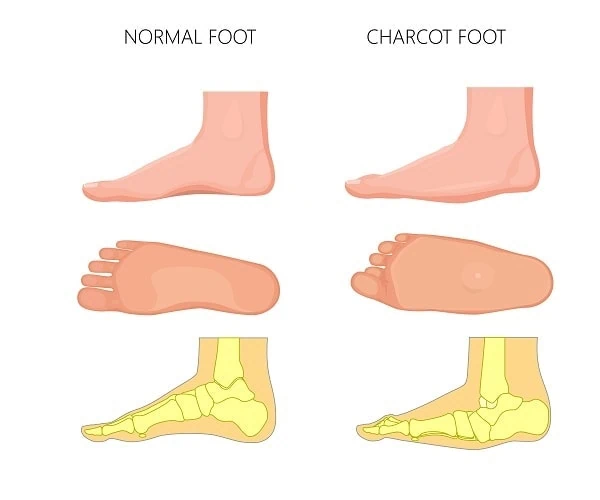The condition Charcot (pronounced “sharko”) foot is one of the most serious foot problems a diabetic can face.
Charcot foot, pronounced as “sharko” foot, represents one of the most severe and concerning complications that can afflict individuals with diabetes. This condition arises due to a complex interplay of factors and poses significant risks to the affected foot.
At its core, Charcot foot is characterized by the fracturing and disintegration of the bones within the foot, which leads to a profound alteration in the foot’s shape. What sets it apart from many other conditions is the absence of pain sensation in the affected foot. This lack of pain perception is a direct consequence of diabetic neuropathy, a common diabetic complication in which nerves are damaged, impairing their ability to transmit pain signals.
The absence of pain can initially appear as a relief for individuals, as they do not experience the discomfort typically associated with a fractured foot. However, this apparent relief is deceptive, as it leads to a dangerous scenario where the person remains unaware of the damage occurring within the foot. Consequently, they continue to bear weight on the affected foot and engage in everyday activities without realizing the extent of the injury.
This continued pressure and stress on the already weakened and fragile bones exacerbate the disintegration and deformity of the foot. Over time, the foot can become severely misshapen, leading to debilitating consequences and a heightened risk of further complications such as ulcers, infections, and even amputation.
The insidious nature of Charcot foot underscores the critical importance of regular foot monitoring for individuals with diabetes. Early detection and intervention are essential for preventing the progression of this condition. Prompt medical attention, including immobilization and offloading of the affected foot, is crucial to halt the destructive cycle and protect the foot from further harm.
 What are the Symptoms and Causes of Charcot Foot?
What are the Symptoms and Causes of Charcot Foot?
Charcot foot is a condition commonly seen in individuals with peripheral neuropathy, particularly those with diabetes. if you’re wondering what the primary causes of Charcot foot are, they are explained in detail below:
1. Peripheral Neuropathy: The most significant cause is peripheral neuropathy, where nerve damage leads to a loss of sensation in the feet. Diabetes is the leading cause of peripheral neuropathy in developed countries. The loss of protective sensation prevents the individual from feeling injuries or stress on the foot.
2. Repetitive Trauma or Minor Injuries: In the absence of pain, small injuries or repetitive trauma can go unnoticed and untreated, leading to progressive damage. These injuries might include walking on uneven surfaces or minor foot deformities that create abnormal pressure points.
3. Poor Blood Supply: People with peripheral arterial disease (PAD) often have poor blood supply to their feet. This reduced circulation can contribute to the development and progression of Charcot foot by impairing healing and leading to bone weakening.
4. Infection: An infection can cause an inflammatory response that weakens the bones and joints in the foot, making them more susceptible to fractures and dislocations.
5. Inflammatory Conditions: Conditions like rheumatoid arthritis and other inflammatory diseases can contribute to the development of Charcot foot due to chronic inflammation weakening the bone structure.
Early diagnosis and intervention are critical to managing Charcot foot. Treatment focuses on offloading pressure from the affected foot, immobilization, and addressing underlying conditions like diabetes and neuropathy to prevent further damage and complications, as explained in the paragraphs below.
Treatment
Treatment for Charcot foot is primarily aimed at preventing further damage, supporting the affected foot, and addressing any deformity that may have developed. The chosen treatment approach will depend on the severity of the condition and the specific needs of the patient.
- Supportive Shoes: Supportive footwear plays a crucial role in managing Charcot foot. These shoes are specially designed to provide stability and reduce pressure on the affected foot. They are often equipped with custom orthotic inserts that help distribute weight evenly and alleviate stress on the fragile bones. Supportive shoes are essential for preventing further damage and promoting the healing process.
- Braces: In less severe cases or during the early stages of Charcot foot, braces may be prescribed. These orthotic devices are tailored to the individual’s foot shape and offer added support and stability. Braces help immobilize the foot, preventing excessive movement that could exacerbate the condition. They are an important component of conservative management.
- Reconstructive Surgery: In cases where the deformity is advanced and conservative measures are insufficient, reconstructive surgery may be considered. This option is typically reserved for severe cases in which the foot’s structure has been significantly altered. Reconstructive surgery aims to realign and stabilize the affected bones, restoring function and preventing further deformity. It is a complex procedure that requires careful planning and expertise, and it may involve the use of screws, plates, or other fixation devices.
Why Choose a Foot and Ankle Surgeon If You’re Suffering from Charcot Foot?
Choosing a foot and ankle surgeon ensures that you receive specialized, comprehensive, and effective care for Charcot foot, ultimately improving your chances of recovery and maintaining a higher quality of life.
Specialized Expertise: Foot and ankle surgeons have specialized training in diagnosing and treating complex foot and ankle conditions, including Charcot foot. Their expertise ensures that you receive the most accurate diagnosis and appropriate treatment plan tailored to your specific condition.
Advanced Treatment Options: These surgeons are skilled in advanced medical and surgical treatments. For Charcot foot, this may include custom orthotics, bracing, and, if necessary, reconstructive surgery to correct deformities and stabilize the foot.
Comprehensive Care: Foot and ankle surgeons provide comprehensive care, addressing all aspects of Charcot foot management. This includes treating the immediate symptoms and complications and focusing on long-term management to prevent recurrence and maintain foot health.
Multidisciplinary Approach: Managing Charcot foot often requires a multidisciplinary approach involving endocrinologists, podiatrists, orthopedists, and other healthcare professionals. Foot and ankle surgeons can coordinate this comprehensive care, ensuring all aspects of your condition are addressed.
Preventing Complications: Charcot foot can lead to severe complications, including foot deformities, ulcers, and infections. A foot and ankle surgeon is trained to identify early signs of these complications and take proactive steps to prevent them, reducing the risk of amputation and other serious outcomes.
Personalized Treatment Plans: Each case of Charcot foot is unique. Foot and ankle surgeons develop personalized treatment plans based on your specific needs, considering factors like the severity of the condition, underlying health issues, and lifestyle.
At Anderson Podiatry Center, relentless dedication to excellence in providing podiatry services, compassion, hope, innovation, and creativity in all that we do drives our doctors to continually train to enhance their knowledge and gain expertise on new developments and innovative treatment solutions. This places us among the leaders in the field of podiatry, neuropathy, and all that involves the foundation of the human body our feet.
